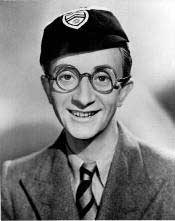Charles Hawtrey (Charles Hawtrey)

Actor. Born George Frederick Joffre Hartree in 1914, in Hounslow, Middlesex, he entered acting at a very early age coming, as he did, from a theatrical family. He is often confused with the Edwardian actor Sir Charles Hawtrey, who is no relation, the name was borrowed by Hawtrey two years after his death. As a child, Hawtrey spent 3 years at the prestigious Italia Conti acting school before moving into the profession proper, in a variety of junior roles. His first appearance came at age 11 and was as an urchin in “The Windmill Man at Boscombe” in 1925. His stage debut was as the ‘White Cat’ and ‘Bootblack’ in “Bluebell in Fairyland” at the Scala Theatre, London. His first radio appearance came in 1929, the start of an great career, leading to his working alongside the legendary Will Hay in “Norman and Henry Bones.” This partnership with Hay was set to resume in 1937, with the comedy “Good Morning Boys” and led to appearances in three other movies alongside Hay (“Where’s that Fire,” “The Ghost of St Michaels,” “The Goose Steps Out”). Throughout his career Hawtrey was justifiably proud of his record on both stage and screen, from the early films appearances in the 1930s, through to a string of theatrical engagements including ‘Gremio’ in the Old Vic’s performance of the “Taming of the Shrew” in 1939. In 1957, he appeared comedy show “The Army Game,” alongside fellow “Carry On” star Bernard Bresslaw. The following year he was included in the first of the “Carry On” series, “Carry On Sergeant”. From his first “Carry On” appearance, he became one of the regular On team members. His scrawny figure and outrageously posh and camp voice typified the eccentric, well meaning figure that he went on to portray in a further 21 films. As time went by, and Hawtrey became synonymous with “Carry On,” he felt he should receive a higher billing than he was getting at the time. He felt that his incredible showbusiness track record should lead to higher billing than that of some of his co-stars in the films. Rogers and Thomas disagreed with Hawtrey, a disagreement which led to his absence from “Carry On Cruising,” and his firing the series, following “Carry On Abroad.” Hawtrey spent his life as a very private person, frequently given to outbursts of often outrageous humour. He was known to speak in a strange nonsense-language, unintelligible to all but his closest friends ( including fellow “Carry On” star Joan Sims). He was an accomplished musician, and during the Second World War, he had been a semi-professional pianist for the armed forces. Following his departure from the “Carry On,” he went into semi retirement, living in an old smugglers’ cottage at Deal, in Kent on England’s South Coast. He appeared infrequently on television in a variety of cameo roles (“Supergran” to name but one). He had suffered from arthritis for many years, but by September 1988, the illness had become so severe, that doctors told him they would have to amputate his legs if he wanted to carry on living. He refused the operation and died a month later at the age of 73. Following his cremation at Mortlake, his ashes were scattered in Plot 50C, and was witnessed by Bernard Walsh. (bio by: Kieran Smith)
Born
- November, 30, 1914
- England
Died
- October, 10, 1988
- England
Cemetery
- Mortlake Crematorium
- England

